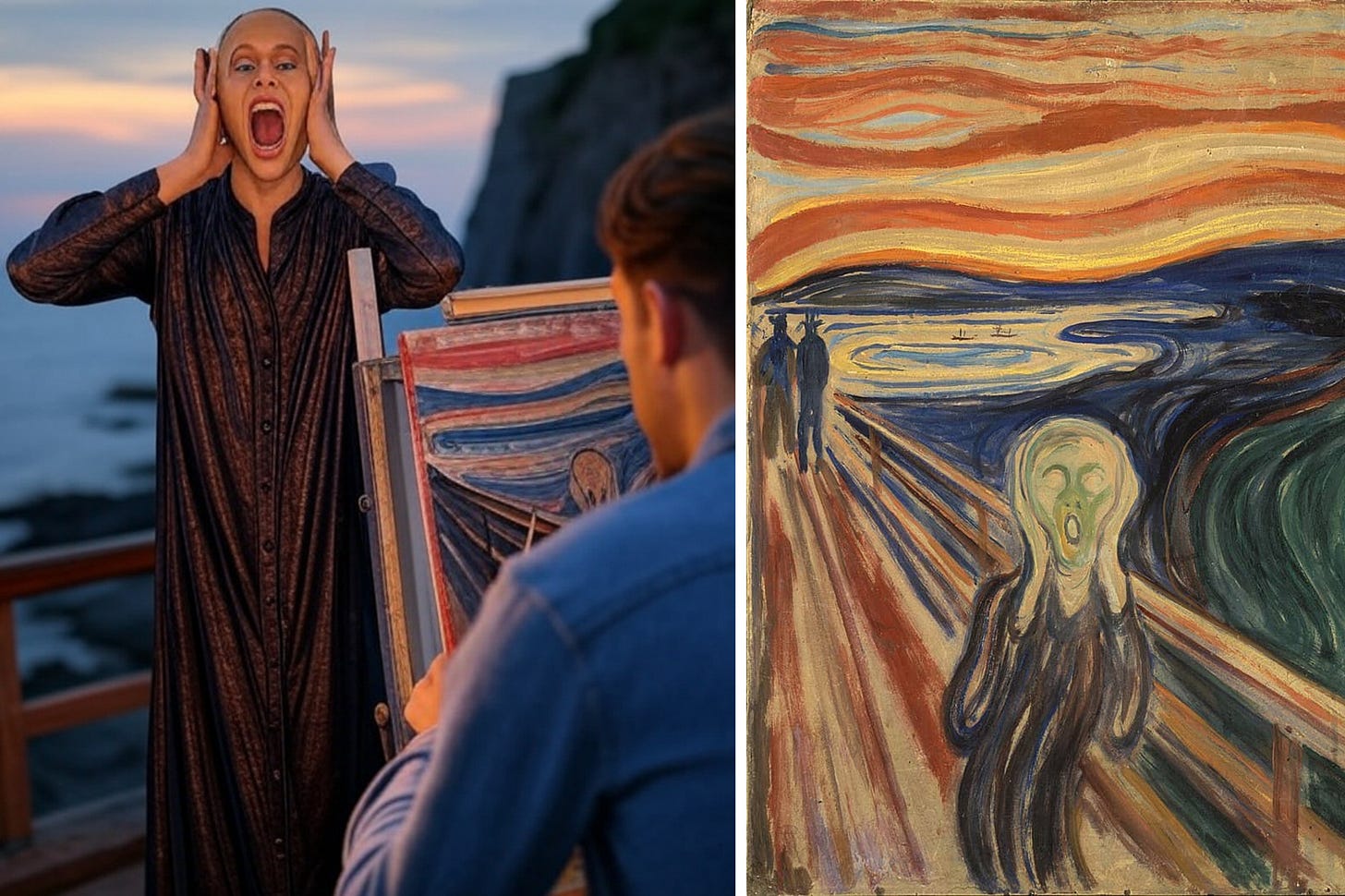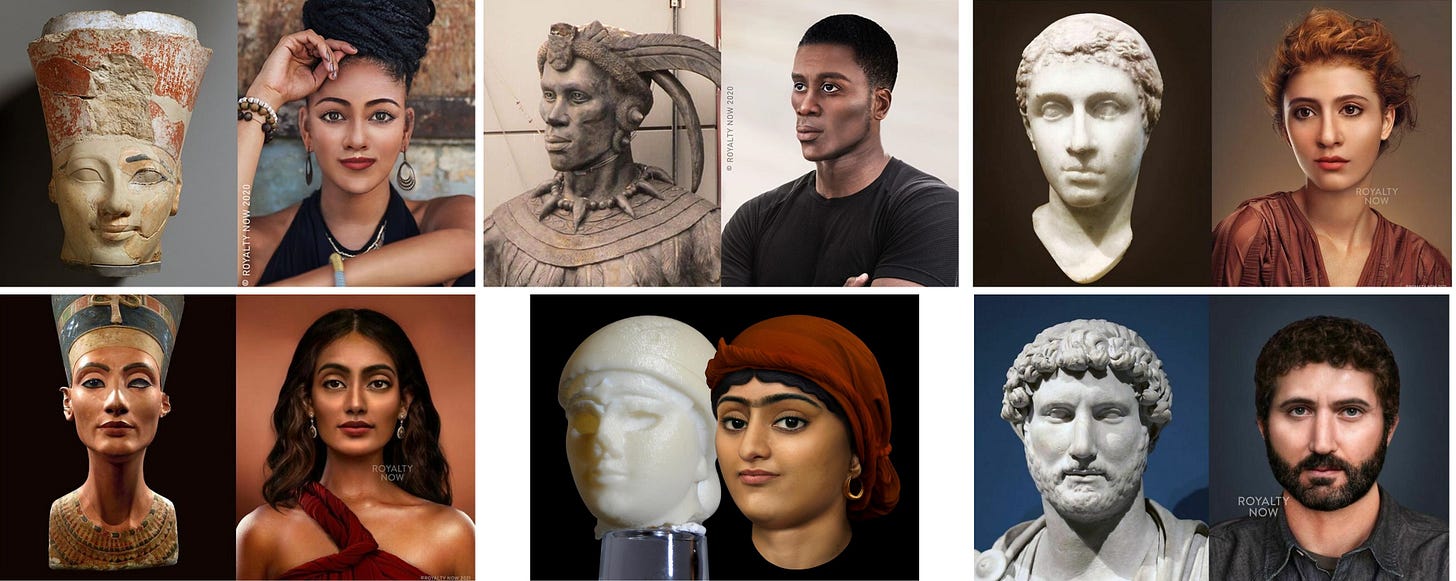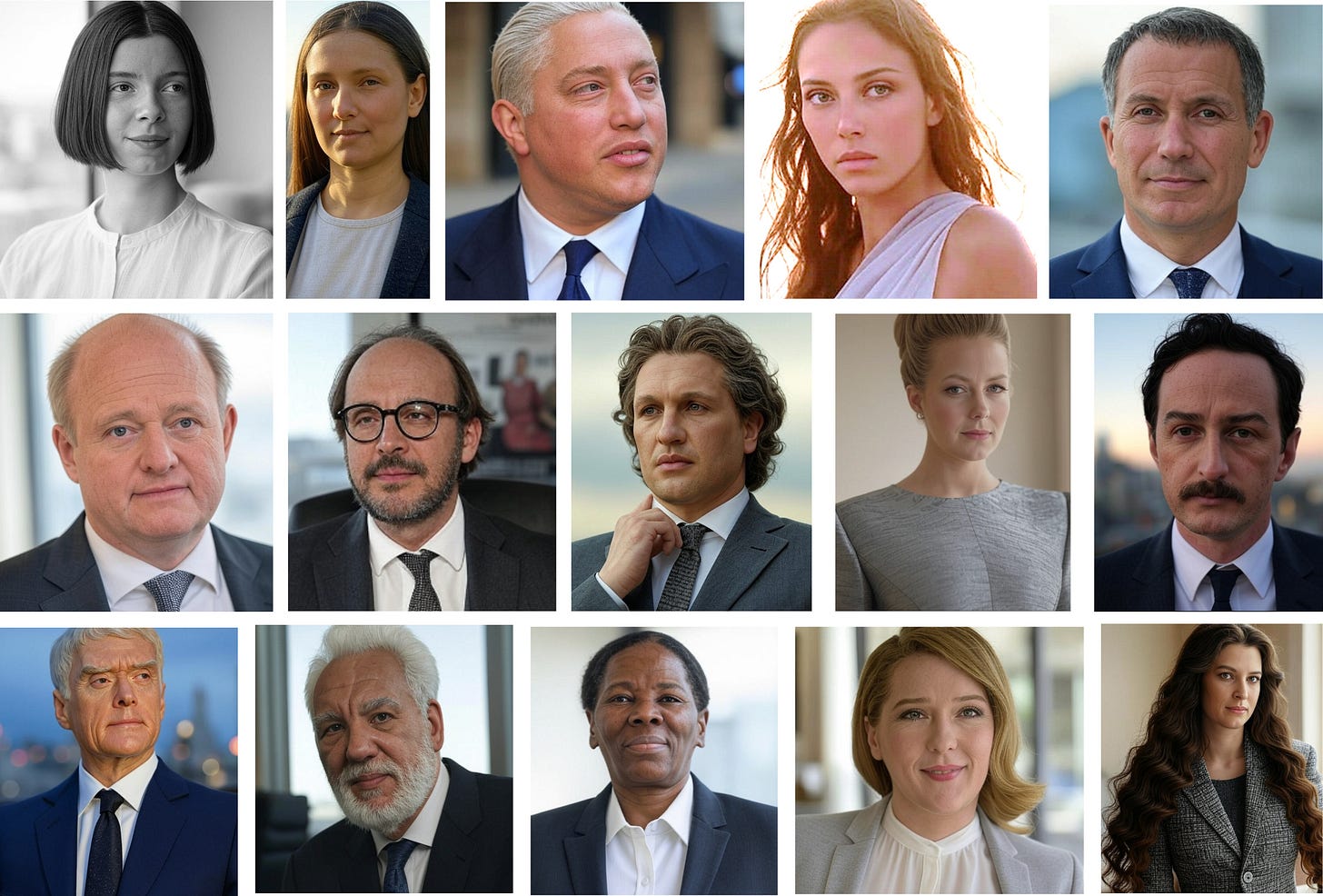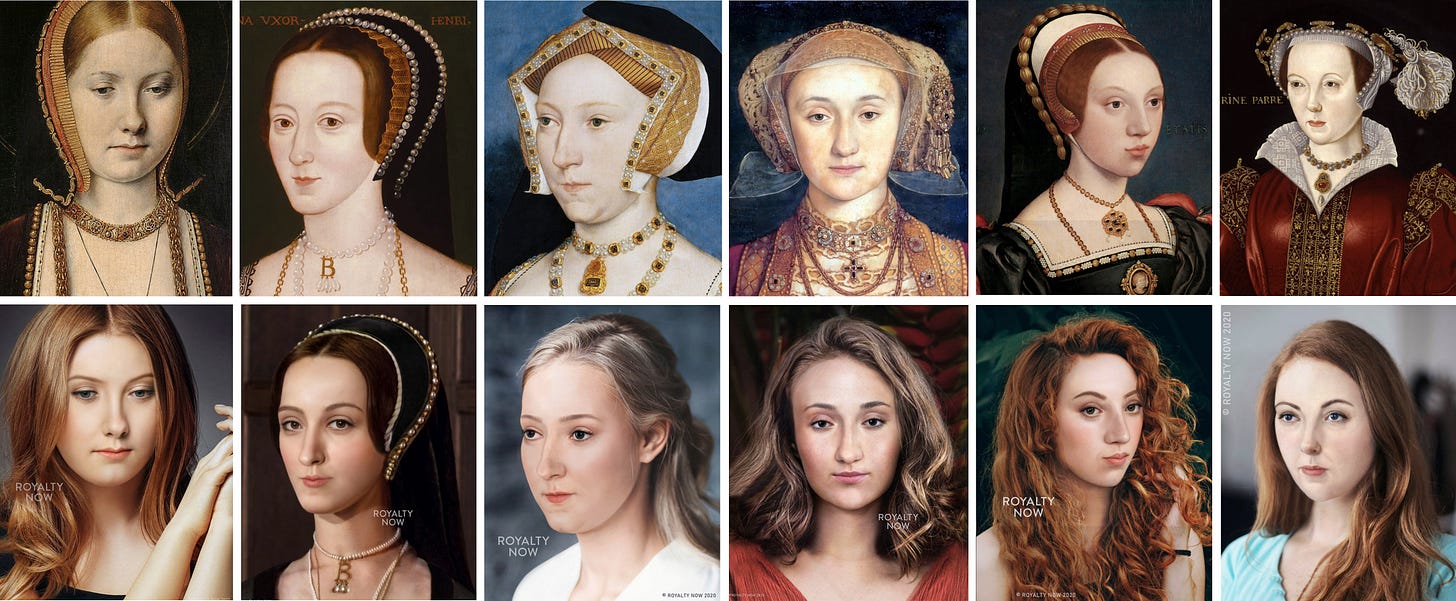I See Dead People (part 1 of 2)
Artificial Intelligence Makeovers: We outfit 30 historical figures in contemporary fashion to rethink their personalities and ponder some societal implications of AI

EXTREME MAKEOVER: TIME-TRAVELER EDITION
I’ve invited 30 mystery guests from across many centuries to attend a 21st century costume party. Each image was produced in seconds by AI (Grok)—though in some cases, it took several tweaks of the prompt to get the right image. I’ll wait till later in the week to reveal their identities, leaving you time to ponder who they might be. You can post your guesses in the comments section, BUT NO MORE THAN ONE NAME/GUESS PER COMMENTER, PLEASE. UPDATE: TAKE ALL THE GUESSES YOU LIKE. (By all means, invite your friends to subscribe and post their guesses.)
The individuals depicted include 4 presidents, 6 kings/emperors/etc., 5 queens/empresses/etc., 2 other national leaders, 1 liberator/activist, 3 writers, 2 actresses, 2 inventor/scientists, 1 spy, 2 accused murderers, and 2 figures from paintings. In the comments, please refer to them by #number. For example, the red-haired woman in row 5 would be #24.
Now, a bit of narrative. Where did I get this modern-makeover idea, and what purposes do they serve?
D’ENTRE LES MORTS (“From Among the Dead”)
“D’Entre Les Morts” was the novel on which Alfred Hitchcock based his masterpiece, Vertigo. In the film, Madeleine Elster (Kim Novak), clad in late-1950s high fashion, seems to be a reincarnation of Carlotta Valdes, a tragic 19th-century local character in San Francisco whose “Portrait of Carlotta” hangs in the Legion of Honor. Carlotta is beautiful, but two-dimensional and unknowable. Madeleine is a fragile bombshell who becomes the obsessive love interest of Scottie Ferguson (Jimmy Stewart). (BTW: As noted in a previous post, “Portrait of Carlotta,” shown below, was painted by John Ferren—my wife’s professor and mentor.)

Around a decade ago, I came across an intriguing piece: “What 10 Famous Historical Figures Would Look Like Today, from Emily Dickinson to Marie Antoinette,” by Natalia Borecka in Lone Wolf magazine. The remake that most impressed me was Emily Dickinson’s, shown above. By present-day standards historic photos of Dickinson give her an odd, other-worldly look. It’s hard to imagine this being the photo of someone around 18 years old. Putting it crassly, her original photo wouldn’t earn many swipe-rights on Tinder.
The Photoshop makeover of Emily Dickinson is an entirely different story. The face from the original photo has been outfitted masterfully with contemporary clothing and hairstyle. As a young person said to me upon seeing this modernization: “Ah! Now I know her. She’s the unconventionally attractive hipster girl in your creative writing class—brooding quietly till she rips your short story to shreds in class discussion.” This Dickinson would get lots of swipe-rights in 2025.
ROYALTY NOW (BECCA SALADIN SEGOVIA)
In the late 2010s, Becca Segovia began issuing dozens (hundreds?) of Photoshopped digital remakes under the brand-name Royalty Now Studios. Consider her makeovers of sculptures below—where she turns cold stone to flesh-and-blood.

As with the Emily Dickinson makeover, Segovia converts remote-looking historical figures into people you might bump into on the sidewalk. Consider her six wives of Henry VIII, below. The originals are quaint, relatively undifferentiated period relics. There’s an impenetrable emotional barrier between their images and our eyes. That changes radically in Segovia’s makeovers.
Catherine of Aragon becomes an erudite fashionista. (BTW, historians debate whether this portrait is actually Catherine.)
Anne Boleyn was a formidable intellectual with a powerful personality, and that shows well in her remake. Contemporary observers disagreed over whether she was beautiful or not, and this stern-faced rendering captures that ambiguity.
Jane Seymour was considered to be Henry’s one true love, and her modernization suggests an innocent, girl-next-door countenance that might have encouraged such fealty from one of history’s least sentimental men.
Anne of Cleves attracted Henry VIII’s eye via a Holbein portrait that showed her as a beauty. Supposedly, he expressed outraged disappointment in her looks when he finally met her. Here, we see the Holbein and Segovia’s modernization of the Holbein portrait. So, we are perhaps seeing Anne not as she was, but rather as Henry thought she was going to be.
Catherine Howard is known to history as highly sexual and unfaithful to Henry—a description difficult to square with the Renaissance portrait. But Segovia’s makeover makes it easy to imagine her recklessness and smouldering allure to men.
Catherine Parr was only 31 when she married Henry and 36 when she died—but looking at her original portrait, it’s hard to think of her as a young person. Segovia’s refashioning makes her youth immediately obvious while leaving the face essentially unchanged.
Segovia’s portfolio includes work for museums, a video blog, and reverse work where she refashions living people in antique garb and style. Among her more intriguing pieces are lifelike portraits crafted from forensic evidence used in identifying the remains of the long-lead Romanov family members.
FROM JOHN HENRY TO CHICO MARX
Here are a few additional thoughts on the implications of this technology:
JOB IMPLICATIONS: In the ballad, “John Henry,” steam-powered drills threaten human steel drivers with professional extinction. John Henry challenges the machine to a contest. He wins, but then dies of exhaustion or a broken heart. AI platforms are today’s steam drills—threatening a wide array of cognitive professions with obsolescence. Tasks that once required a skilled Photoshop expert can now be done reasonably well by any novice with access to AI.
SPEED AND SIMPLICITY: I asked Becca Segovia how long it took her to produce her Photoshop portraits, and her answer was “up to eight hours.” In contrast, many of my makeovers required only a few seconds and a single prompt (e.g., “Give me a photograph of John Doe in modern clothing and hairstyle.”). Some required multiple prompts to get the look I wanted—sometimes with slightly tweaked wording. Some required a bit of post-production work (corrections in color, contrast, brightness, focus, etc.) Only one required editing—and I’ll explain that special case when I post the identities a few days from now. None of the images took more than around fifteen minutes. By the way, I asked Segovia whether she is using AI nowadays, and she told me:
“I use AI sparingly for backgrounds, and for help with hair and other textures that are difficult to photocomposite. It has definitely made the process faster in some ways, maybe saving an hour or two overall. I still primarily use Photoshop as my tool.”
EMOTIONAL DISTANCE: Becca Segovia’s makeovers typically take on the appearance of formal portraits. My own AI makeovers look more like random pics snapped with an iPhone. I think it gives them a more casual, intimate, familiar look than the work of people like Segovia. That isn’t to say “better” or “more artistic”—it’s just a different product with different emotional impact.
VERSATILITY: AI also offers degree of versatility difficult for even the best Photoshop artists to attain. In the Royalty Now and Lone Wolf offerings, the facial expressions in the makeovers are usually nearly identical to the expressions in the originals. This is useful, both for ease of execution and for probability of recognition. AI offers vastly greater degrees of freedom. In “Surprising Selfies, Celestial Cities, and Censorship Stanzas,” for instance, I created warm, smiling selfies for seven historical and fictional personages not known for their warm, sunny smiles. Add to all of this that such photos can now be animated and voiced, using more advanced AI platforms.
NOT GREAT, BUT GOOD ENOUGH: If you’re looking for great art, AI is unlikely to be its source (though great artists are beginning to use AI in creating their works). But if you’re only looking for good-enough art (or poetry or prose or computer code)—say, to illustrate a blog post—AI’s output can be, well … good enough. A non-artist (like me) can turn out perfectly good commercial art copy in seconds instead of hours—and without the up-front investment costs of art school.
SOCIAL TRUST: The rapid improvement in AI technologies means that individuals and societal institutions will have to radically adjust what constitutes persuasive evidence—legal, scientific, personal, etc. I am now highly skeptical of “photos” that I see on social media—of politicians, landscapes, or flowers. Until we settle on a new evidentiary equilibrium, we will often believe the fake and disbelieve the authentic. The premier dilemma of our era may come from Chico Marx’s immortal question: “Who you gonna believe—me, or your eyes?”
THEY SHALL NOT GROW OLD
Digital technology gives us a previously impossible capacity to “know” long-dead people viscerally, intimately. Still, it raises ethical questions regarding use of other people’s images—even long-dead people’s images. My earlier post, “That the Past Shall Not Grow Old,” described how director Peter Jackson used AI to bring World War I soldiers back to life by bestowing sound, color, and natural motion upon silent, black-and-white, jerky period film footage—and the questions raised about whether one ought to do what Jackson did. (I’m a big fan of what he did.) Here’s a five-minute video on how Jackson brought the soldiers and battlefields of World War I back to life—and why:









#24 Queen Elizabeth I
#2 Mona Lisa